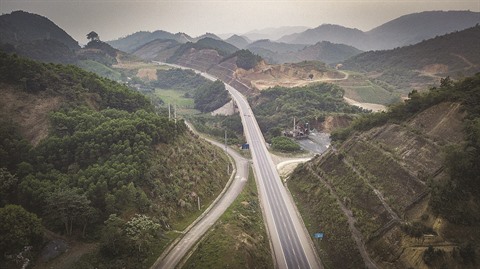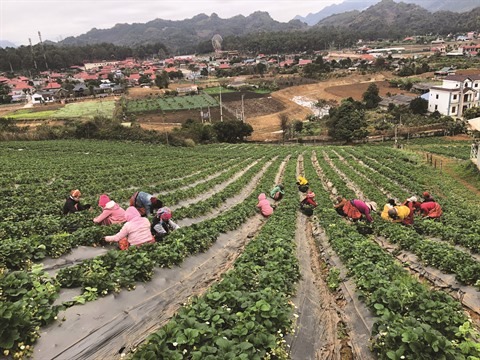>>Create a new breakthrough for the Middle and Upper North region
>>Specific tourist products of the northern mountainous region
|
|
|
Policymaking needs to be adjusted to awaken potential benefits of the middle and upper region of the North. Photo: Huong Linh/CVN
|
“Overall national planning in general and regional planning in particular will make it possible to determine the shortest and most scientific way in the organization of space, orientation and modes of development adapted to each period”, indicated the Minister of Planning and Investment, Nguyên Chi Dung.
According to him, for high-quality land use planning, the link between localities is important, allowing each to better benefit from its respective advantages.
Mr. Dung calls on the provincial levels to tackle this issue head-on and not rely solely on state labor and funds to develop infrastructure.
The planning of the middle and high northern region is an opportunity to assess and identify problems in a comprehensive way, clearly define the views, objectives and directions of development by organizing the development space, exploiting and valuing to the maximum its potential, strengths, comparative advantages and ultimately trying to turn difficulties and challenges into opportunities.
In recent times, connection activities have been the subject of concern, which is why the focus has for several years already been on investments in interregional transport infrastructure and the development of border economic zones as well as on cooperation cross-border.
Remedy the limits
However, intra-regional ties and those with the Red River Delta and capital regions are still too weak, according to the minister. The development space is divided into administrative borders that do not yet allow the potentials and advantages of the localities of this region to be sufficiently valued.
Minister Nguyên Chi Dung sees several causes for this situation: First, there is not yet a liaison mechanism and regional coordinating council.
Second, there is a lack of resources to implement regional linkage policies.
Third, prior to the publication of the Planning Act, the role of regional and area planning was still unclear. There is a lack of links between the different levels of decision-making: strategy, development, planning and investment.
Fourthly, the system of transport infrastructure, connecting roads between localities is insufficient. Intra-regional lines did not receive investments synchronously. In particular, the road network linking the East to the West is still weak. Coordination between transport modes is not reasonable. The border communication channels also encounter many difficulties. The railway infrastructure is not suitable for international connections.
Fifth, the cooperation mechanism remains formal and inefficient. Localities only focus on development within their administrative boundaries, rarely coordinating with neighboring provinces to promote benefits.
Sixth, regional databases of key products, human resources, sectors, fields and advantageous products are still too few, which leads to inefficiency in cross-regional and cross-regional cooperation.
Integrated and multi-sector management

|
|
Transport infrastructure is one of the driving forces behind the development of the middle and upper region of the North. Photo: VNA/CVN
|
In order to overcome these weaknesses, spatial planning in these regions should focus on the following points: Strictly follow the planning process and strengthen the participation and coordination of the parties concerned. The Planning Act creates a new stage of this work, considering it as an important part in the national planning system for the period 2021-2030 and a 2050 vision. In the Act, emphasis is placed on the development space and planning design process is approached in an integrated and multi-sectoral direction with emphasis on the involvement of ministries, sectors and localities to address cross-sectoral and cross-regional issues.
Directions on the regional development linkage should be addressed clearly in the development of regional and provincial plans. Its contents should show the liaison requirements, role and responsibilities of each locality. It is necessary to unify the objectives of development, the attraction of the investments between the localities to limit any unhealthy competition.
It is necessary to concentrate on the planning of infrastructures, in particular those of transport, to closely link the development of a territory with that of the regional economic corridors.
Transport infrastructure is one of the drivers of local development. Accordingly, by 2030, it is important to accelerate the construction, complete and modernize the transport network. This will create a connection between the dynamic economic zone which includes the provinces of Bac Giang, Thai Nguyên and Phu Tho to the capital region.
Other objectives have been defined: To form economic and urban centers that will act as engines of development for the whole region. Found industrial production chains, linking exploitation to manufacturing and processing.
Develop the agricultural value chain by improving the value of products, connecting localities in the region to form specific large-scale production areas.
Strengthen agrotourism and expand forest area certified for sustainable management to serve the wood processing industry for export and domestic consumption.
Create a connection in urban and rural development with industrial areas and border economic areas. Establish a liaison mechanism in the mobilization of investment resources to ensure the implementation of regional and interregional projects. For capital from the state budget, priority is given to major socio-economic infrastructure works, in particular the completion and restoration of national roads and those linking to the Hanoi-Lào Cai highway.
For sources of capital outside the state budget: the middle and high northern region being relatively less competitive than neighboring areas, it is therefore necessary to study specific and adequate mechanisms to attract investment there.
We would love to thank the author of this short article for this awesome content
Connection, the basis of regional development
Visit our social media accounts along with other related pageshttps://nimblespirit.com/related-pages/

